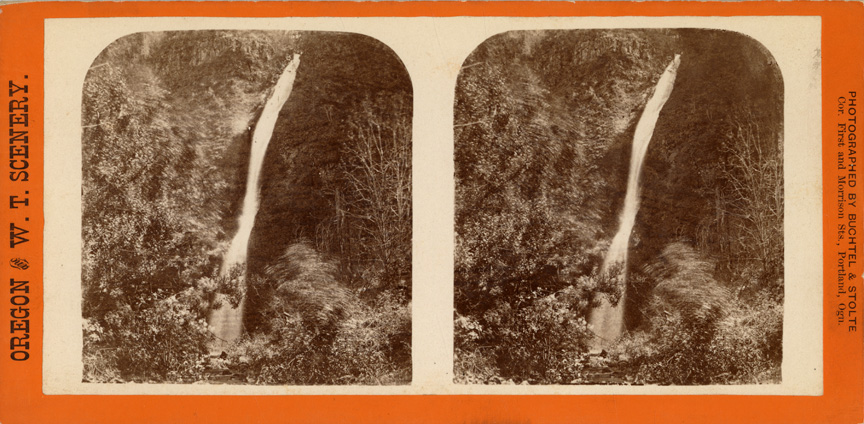- Catalog No. —
- bc00607
- Date —
- circa 1860
- Era —
- 1846-1880 (Treaties, Civil War, and Immigration)
- Themes —
- Arts
- Credits —
- Joseph Buchtel photographs [graphic], Org. Lot 211, Oregon Historical Society Research Library
- Regions —
- Columbia River Portland Metropolitan
- Author —
- Joseph Buchtel (1830-1916), photographer
Horsetail Falls by Joseph Buchtel
This stereograph of Horsetail Falls by Joseph Buchtel was likely taken in the 1860s. The falls can be seen from the Historic Columbia River Highway, falling approximately 176 feet from Horsetail Creek. The falls resemble a horse’s tail and the descriptive name given by Oregon pioneers remains on today’s maps.
Stereographs like this one were invented in the 1840s by Charles Wheatstone. When viewed through special lenses, the side-by-side photographs create an illusion of depth by showing two slightly different images at the same time. Stereographs were popular throughout the nineteenth century and into the twentieth for entertainment and education. The viewer, or stereoscope, was relatively cheap and allowed people to travel “virtually” around the world. Millions of stereographs were produced and sold before movies supplanted their popularity.
Joseph Buchtel was one of the first photographers to use stereography in the Columbia River Gorge. He arrived in Portland in 1853 when he was 23 years old and stayed in the area for the next 27 years (1880). His first job in Portland was in the Leland H. Wakefield daguerreotype studio on Front Street, a business he took over soon after he joined the studio.
Buchtel traveled throughout the state with his portable camera equipment and ran his Portland studio until 1858. He also worked as a steward on river boats. He was present for one of the more serious riverboat accidents on the Willamette in the spring of 1854. When the ship Gazelle’s boiler exploded killing 20, Buchtel pulled at least 8 people to safety. He went on to save at least 40 more throughout his stewarding career.
In 1858, Buchtel and his new partner Holland moved their studio to Oregon City. This partnership was short-lived, however, and Buchtel returned to Portland in 1859 to partner with Byron P. Cardwell. This partnership was enormously beneficial for both men, leading to increased business and commendation from both the public and the photographic community. In 1861, Buchtel managed the pavilion at the first Oregon State Fair and won awards for his and Cardwell’s exhibit of Oregon biota.
In 1862, Buchtel won his first elected office as First Assistant to the foreman of the Multnomah fire engine company. In 1863 he campaigned for and won the office of Chief of the Fire Department, a seat he held for two years.
Buchtel continued his photography career in partnership with A.B. Woodward, and in 1865, he was commissioned to take photographs of Fort Vancouver, the first panoramic photos ever taken by an Oregon photographer. He continued to grow his business and be active in the community, including organizing the Pioneer Baseball Club in 1866. His eventual partnership with E.H. Stolte moved him into picture framing and retail sales. Together they produced hundreds of photos of Portland and the surrounding area which they exhibited around the country.
In 1880, Buchtel suffered two tragedies. His son died suddenly in August, followed by the sale of his studio to W.H. Towne. When Buchtel traveled east for a short time after the sale, Towne took the opportunity to throw out nearly all of Buchtel’s negatives. Fred Lockley rescued some of the negatives which are now housed in the Oregon Historical Society Research Library. The loss was devastating.
The death of his son and the destruction of his life’s work effectively ended Buchtel’s photographic career, although he kept a small studio open in Portland for several years. He is recognized as one of the greatest portrait photographers in Oregon and was honored with a street name in Portland (now SE 30th Ave). He died August 10, 1916.
Written by Amy Platt, © Oregon Historical Society, 2008.
